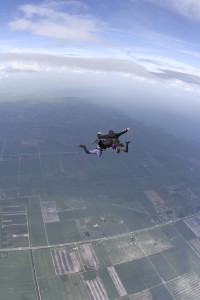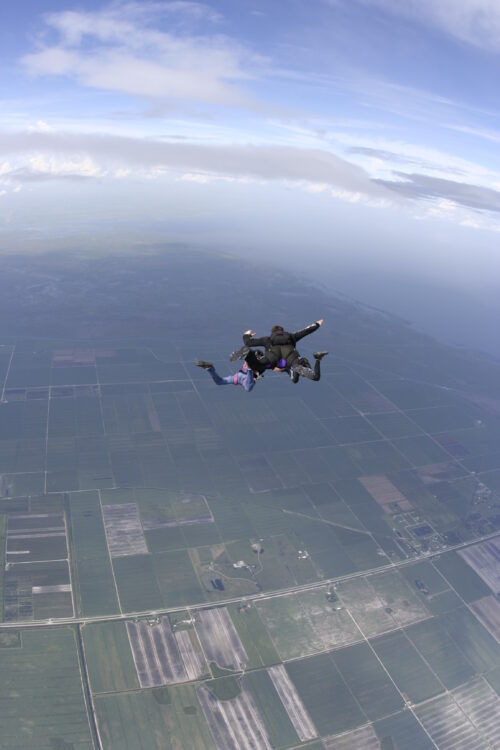Any person with a television has seen dozens of skydives during their lifetime. Maybe that’s why parachuting shows up on so many people’s Bucket Lists. A death-defying, easily accessible, affordable adrenaline rush is how it’s marketed. The movie that is probably most responsible for pushing skydiving from the fringe to popular culture is Point Break. But anyone who has ever jumped out of a plane and entrusted their lives to some strings and cloth knows that they fill movies like Point Break with the impossible. There are of course, things they don’t tell you about skydiving.
In 2009 I went to Air Adventures Florida and made two jumps from 12,000 feet. After the second jump, my instructor explained that what he usually recommended was two tandem jumps before making a solo. Something you might keep in mind if you ever decide to go parachuting. Here are some skydiving facts that you can’t learn from watching movies.

Skydiving from 12,000 feet
1. No Talking
In the movies, characters yak and yak to each other while in free fall. In real life, ‘totally impossible’. Shortly after jumping out of the plane you reach 120+mph. At that speed the wind is deafening and if you open your mouth you can feeling the cold air blasting down your throat. Scream all you want, no one can hear you. Sky divers use hand signals to communicate.
2. The Falling Sensation Doesn’t Last
The strange thing about skydiving is that the falling sensation lasts only for a few seconds, afterwards the deafening wind beating your ears, the cold, and the speed will be what gets noticed most. It is easy to become transfixed by these sensations and forget the inherent danger of hitting the ground after falling from two miles up. This may be why, every year a few skydivers die. Some simply forget to pull their chutes.
3. It’s Cold
Cold is a relative term. I went skydiving in Florida during the summer. While the temperature on the ground was 95 degrees, at 12,000 feet , the temperature inside the un-pressurized cabin was 65 degrees.
4. After you pull the ripcord, you go up.
No. In the movies it always appears that the person goes up after they open their chute. It looks like that because the camera man is also falling at 120 mph, when the actor (stuntman) pulls his ripcord his speed drops dramatically from 120 mph to 30 mph. Since the camera is falling at 120 mph it looks as if the other person is going up, but actually it’s the camera going down.
Now that you know what doesn’t happen, here is what does.
There is a jolt as the parachute opens, the equivalent of falling from a low ceiling and landing in a bed. Held securely in the harness under the chute, the feeling of speed is replaced with being suspended in mid-air, because of the type of chute you can turn left or right, speed up or slow down.. The horizon shrinks and the ground temperature of 95 degrees rises to meet you. Turn into the wind, flare to slow down, put your feet together, hit the ground and slide. Stand up to let your fellow jumpers know that you’re alive.
Before you get on the plane for your first jump, there will be several hours of ground school. One of the most important things you will learn is how to keep yourself steady while falling. A wrong move can cause you to tumble out of control, and that ain’t good.
Other Things to Know
Skydiving is empowering (an overused word, I know) The first thing taught is that YOU are responsible for every aspect of the jump. If you follow every instruction correctly but end up dead, it was your fault, if you follow no instruction and do whatever blind panic tells you to do and survive it was a good jump (failing grade for the jump, however) You are in freefall for one minute and during that time the decisions you make and the actions you take will decide whether you live or die. At 120 mph there are several things you must remember to do correctly or else. . . . (Dramatic isn’t it. Actually there are two safety devices that ensure at least one of your two parachutes will open before you reach six hundred feet, but it is still risky. Here is why you should take risks).
Is it easy? It should be as easy as falling out of an airplane but, no. There is a degree of physical fitness, the chute and harness weigh about 40 pounds and as you fall you must hold your body in the correct position or you spin.
Can you do it? Yes, but know this, there are over 330 million Americans but only thirty-three thousand registered skydivers, obviously not for everyone.
Should you do it ? Consult your Bucket List.

You have saved my life! I have scratched this off bucket list. Too much work. Too much thinking. I could end badly:-)
Good post!
I’ve been surfing online more than 3 hours today, yet I never found any interesting article like yours Skydiving: 4 Things You Won’t Learn From A Movie | Writings of A Mid-life Man. It was worth it. In my view, if all website owners and bloggers made good content as you did, the internet will be much more useful than ever before.
Hey There. I found your blog using msn. That is a really smartly written article. I will make sure to bookmark it and come back to read more of your helpful info. Thanks for the post. I will certainly comeback.
Glad you liked it.
Jeremy, good for you! I assume you were going through an AFF course? Did you do any tandems or just start with AFF? Two jumps with your own rig is lots more than most people 🙂
Kurt
Just started with Accelerated Free Fall (AFF), though after the second jump the instructor told me that I should have done at least one tandem so I’d know what to expect.
It should be termed AHA, ‘Accelerated Heart Attack’
Hey, I think your website might be having browser compatibility issues.
When I look at your blog site in Safari, it looks
fine but when opening in Internet Explorer,
it has some overlapping. I just wanted to give you a quick heads up!
Other then that, superb blog!
Thanks for tip I’ll have a look into it.
Amazing. I agree.
Thanks! Glad you liked what you read.